SEO can be an important factor in generating sales leads for your business. It's not enough to create a website and hope people find you, you need to put some work into getting it noticed by search engines like Google.
Our return guest is SEOLeverage's Gert Mellak, back to share best lead gen practices for business owners. Tune in and discover how SEO can work on its own or with other strategies to bring in the leads you need.
Podcast: Download (Duration: 19:17 — 17.8MB)
Get Notified Of Future Episodes Apple Podcasts | Spotify | Amazon Music | Android | Blubrry | Gaana | TuneIn | Deezer | Anghami | RSS | More
Episode highlights:
01:36 – You’ve got the ranking – now what? A lot of business owners are after page one, but are unclear on what comes next.
02:20 – Just so you know what leads are… James and Gert make sure everyone’s on the same page.
04:10 – Leads via paid ads versus via SEO. A lot of people rely on paid ads as their lead generator. Do they still need SEO?
06:23 – A common objection to SEO. How can something so difficult and time-consuming be worth the effort?
09:24 – The things you can tune to boost lead gen. Sometimes it’s a small tweak to your content plan, sometimes a change of focus.
12:01 – The kind of results Gert has seen. Does it really work? Here’s proof…
14:19 – Your SEO’s working – do you drop everything else? So your SEO’s getting results. What happens to your paid ads?
17:19 – Gert’s action steps for the listener. Here’s what you can do after listening.
Be on top of the best marketing practices with help from James
Mention SEO on SuperFastBusiness, and you can expect an appearance from SEO pro Gert Mellak. Gert is back from a well-earned vacation, and today he and James will be discussing how to get leads from your website using SEO.
You’ve got the ranking – now what?
Sales leads from SEO are something a lot of people are missing out on. Gert and his team at SEOLeverage do a lot of website audits, and talk to a lot of site owners. A recurring theme is that people are focused on rank, but not really clear on what to do once they have the traffic.
More than half their clients, says Gert, are ultimately interested in inquiries, in leads, in people raising their hand, saying, Look, I like your content, I like what you’re doing, I might need your help. This, however, is often forgotten in their bid for higher ranking.
What of the other half, asks James? Do they just want sales?
That half, says Gert, are probably either looking for sales directly or in the e-commerce space.
Just so you know what leads are…
Some definition may be in order. When James and Gert speak of leads, they mean using your website to capture an email address or a chat discussion that can turn into some kind of a sale at some point later.
It’s usually an opt-in for something downloadable, says Gert, or an inquiry, a feedback form or contact form that’s filled in. And then every product then defines leads a little bit differently. Very often, it’s just to populate an email list. Sometimes, it’s really specific inquiries. Clicks on a mobile phone or a phone number could also be leads. So they definitely want to discriminate based on the project.
For example, says James, when someone comes to SuperFastBusiness, it will detect if they’re using an iPhone, and ask them if they want the SFB app. That’s a way to capture a subscriber of sorts. But they had to get to the site in the first place. And what he and Gert are suggesting is that that can be done with SEO. So you’re getting them in from the content, and when they’re there, you’re asking them to do something that will help you in the future.
SuperFastBusiness also offers transcriptions of podcast episodes for download, with occasionally a checklist or framework. When people opt in, James can then stay in touch and update them on new episodes, as well as information on the membership, where he can coach them and help them grow their business.
Leads via paid ads versus via SEO
A lot of people, James would say, are really caught up in the paid ads game. That’s what people talk about a lot when referring to a lead generator. But Gert is saying, if you’re going to do all that extra effort, why not capture the leads from your SEO?
“SEO is an important pillar, and you will definitely want to leverage it to its best.”
Absolutely, says Gert. It’s something they encounter often. People check Analytics to see how much traffic they get from SEO, and then they check their paid ads to see how many leads they generate. But they don’t often think to combine the two. SEO is not the only pillar you need in your content marketing strategy. Ads are valuable as well. But it’s an important pillar, and you will definitely want to leverage it to its best.
Very often, SEO leads show higher conversion than ads, because people finding you through Google search feel like they’ve done their own research. They may click on an ad if it’s interesting and relevant enough, but there’s still that feeling that they were directed, or tricked, you might say, to view that particular brand or product.
A common objection to SEO
But SEO takes time, says James, and it’s confusing to figure out. Gert must have heard that before.
Gert thinks SEO scares off people who have done it, and focused a lot of time and energy on the wrong things. This is where SEO Leverage build out their ERICA framework. Essentially, you could do 200 things, all good for SEO, but there might be just four things you need to focus on for a couple of weeks. That’s where Gert and his team have done a very good job for their clients.
So focus, or lack of focus, is a big reason why people don’t succeed in SEO.
James certainly appreciates the short Loom updates he and his team receive from Gert: what they’re getting results for, where the target is, and what things they need to do to home in on that target. A lot of businesses, he says, are more concerned with ranking for vanity keywords that don’t make money.
With the proper focus, some work and a bit of help, you can build a strong pillar of SEO and get results. You won’t need to rely so much on paid ads – should you ever need to switch them off, you’ve got traffic and leads to fall back on.
The things you can tune to boost lead gen
What are some things you can work on? Gert has had James do a few things on his site – tweak the header, prune back content, promote posts with internal linking, rewrite old content.
Sometimes it’s small things, says Gert. And it’s really the focus that changes things. People think their SEO is okay if traffic skyrockets, but that’s really just vanity. If you want leads, there might be only a handful of articles on your site right now that drive lead gen. And most of the websites Gert audits don’t even have tracking in place. So people don’t even know which articles bring in leads.
This is where Gert and his team have developed a KPI overview for clients. It shows which articles drive traffic, which drive leads, the conversion rates, and which articles are doing better or worse month after month. This makes it easy to do a content audit and say, these are five articles we really depend on – let’s make them the special focus.
If, with those articles, they identify topics that resonate with their audience and trigger them to take the next step, they can make a content plan around them. They can place more content about those articles on YouTube and other platforms, maybe use the intel for paid ads as well, run a display or a YouTube ads campaign about it.
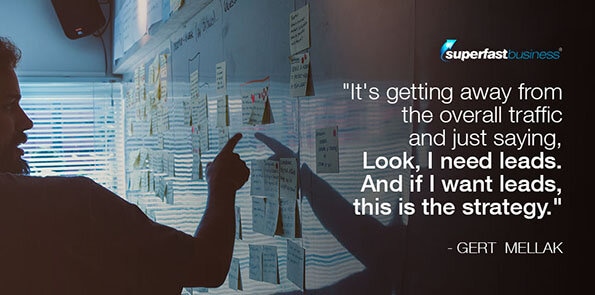 It’s getting away from the overall traffic and just saying, Look, I need leads. And if I want leads, this is the strategy.
It’s getting away from the overall traffic and just saying, Look, I need leads. And if I want leads, this is the strategy.
And you don’t want to focus on old traffic. You might have a 20 percent traffic drop and at the same time, a 10 percent conversion increase. These things happen because Google shifts gears. And once Google knows that your conversion-driving articles are the best, they’re going to give you the exposure.
“We don’t want to focus on old traffic.”
The kind of results Gert has seen
Gert has seen massive results with clients, especially when putting in calls to action where needed. Some customers had really good content, others needed rewriting based on what Google currently wants to see.
Take note, your call to action might not be visible on every device. Gert got great results fixing this for clients.
He remembers getting 3X conversions for a project in the online course space. They focused on a few articles that drove conversions and improved them with specific calls to action and different ways to catch those conversions.
Another client doubled or tripled leads after refreshing their articles.
One client changed their lead magnet per Gert’s advice and got 50 more leads every month for free.
It’s really this focus, says Gert, on first, tracking; second, identifying what is working for you. And then third, trying to scale this and make sure it’s better.
Your SEO’s working – do you drop everything else?
So say you’ve put in the effort, says James, and you’re getting the opt-ins. Do you stop your paid ads?
I’m always fond of never stopping something that works, says Gert.
That was James’s answer, too.
You don’t know how long something’s going to work, Gert says. Never change something that’s working. He’s a programmer by trade. Whatever was working, they never touched it. They just tried to tweak it a little.
If you have something that works, that’s great. But imagine how far down your average cost per lead could come if you added an organic pillar and got free leads into the mix.
Consider also if your paid ads stopped. Gert had a client whose ad account got blocked. They had just started SEO, had no rankings in place. They lost half of their year’s revenue because they were only relying on paid ads.
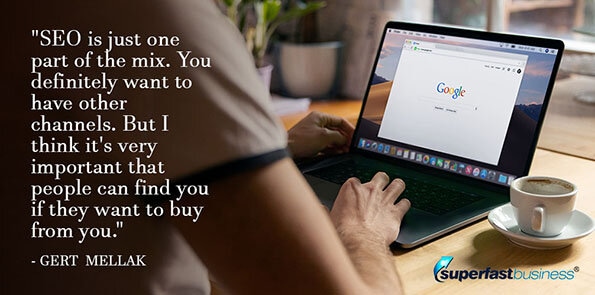 If a channel fails you or the macroeconomic situation is not playing in your favor, you really want people to still find your business if they search for what you’re selling. SEO is just one part of the mix, says Gert. You definitely want to have other channels. But he thinks it’s very important that people can find you if they want to buy from you.
If a channel fails you or the macroeconomic situation is not playing in your favor, you really want people to still find your business if they search for what you’re selling. SEO is just one part of the mix, says Gert. You definitely want to have other channels. But he thinks it’s very important that people can find you if they want to buy from you.
And James supposes you can adjust your campaigns depending on seasons and so forth, if you’re not reliant on that.
Absolutely, Gert says.
James loves Gert’s overall philosophy, and it fits in well with his other guests on the show. They’ve been talking about podcasts, videos, getting Facebook, Google, YouTube campaigns running. They talk about SEO, and about good copywriting – it all fits together.
Gert’s action steps for the listener
What would Gert advise someone listening to this episode?
Definitely consider dedicating resources to SEO, or shifting a little bit of the paid ads budget to SEO, in order to build something up. Don’t just spend time and money to get a little bit more out, but really build something, create something you can optimize over time. And this is going to bring costs down, and it’s going to put you in a safer position.
James loves it. And he loves as well what Gert is doing with his YouTube channel these days. He definitely practices his own ideas, one of which is to have consistent different sources of traffic.
The consistency is something they picked up from SuperFastBusiness, says Gert. Like other members, he’s been sharing his videos in the forum and getting feedback.
James wants to credit his new iMac to a video one other SFBer, Julian, posted, about why he liked the model. Videos are a powerful thing.
Expect to hear more of Gert in the future. If you’ve got a question you’d like addressed, hit reply on one of James’s emails, and he’ll grill Gert on the latest in SEO.
Make the most of your business journey with James’s help
Get SEO help that yields results – look for Gert at SEOLeverage.com
Liked the show? Enjoy all the episodes when you subscribe on iTunes
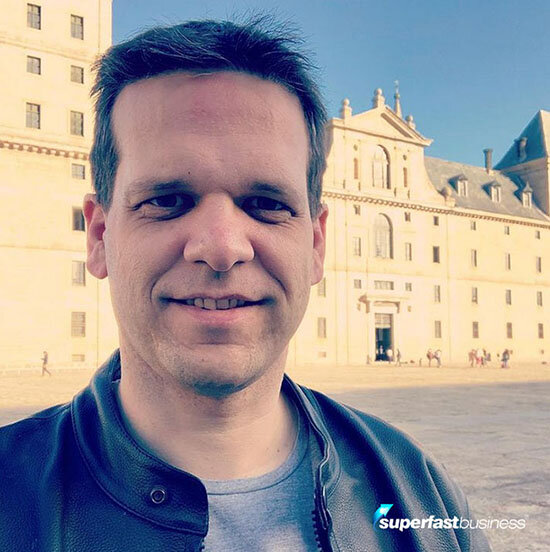
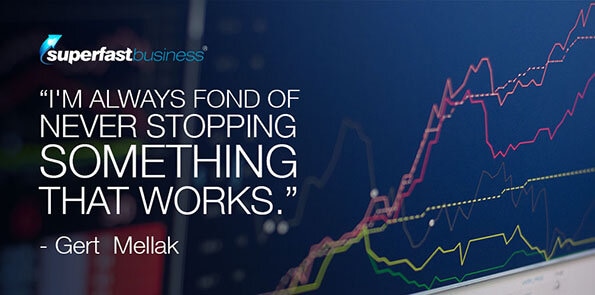
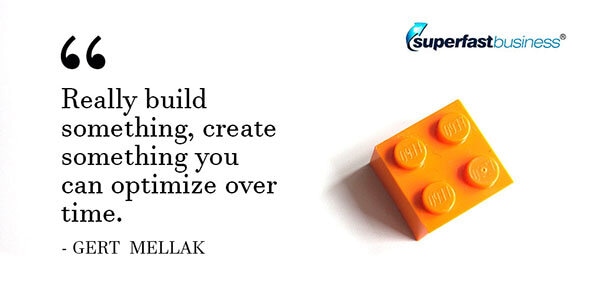









Leave a Reply